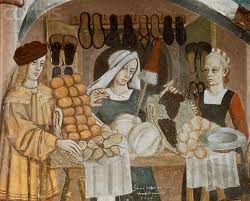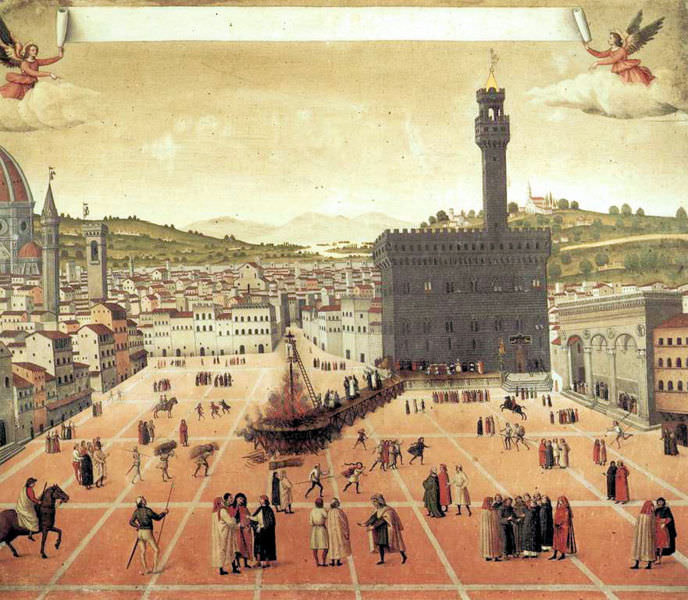The beginnings of Florence Cathedral. A political interpretation
That the Cathedral project emerged in the context of the complex struggle between elite and popolo in 1293-95 already suggests its heavily politicized origins.
Jews and Magic in Medici Florence
Between 1615 and 1620, Benedetto Blanis (c.1580-c.1647), a Jewish scholar and businessman in the Florentine ghetto, sent 196 letters to Don Giovanni dei Medici (1567-1621), an influential member of the ruling family.
Long Distance Trade Partnerships and Social dynamic in Medieval Genoa
Likewise, for those specifically addressing the transition from feudalism to capitalism, the participation of the dominant class to the Italian medieval commercial revolution often run contrary to account that pits the nobility against the urban merchants.
‘Guelphs! Faction, Liberty and Sovereignty: Inquiries about the Quattrocento’
Such an approach has not always been the obvious one, as the centuries- long debate about the nature of the Italian noble (or magnate) and Popolo fac- tions suggests. Gaetano Salvemini’s 1899 interpretation of Florentine political conflict in the thirteenth century as the clash between two groups with distinct socio-economic characters and political programmes was probably as much indebted to Machiavelli as to the author’s socialist beliefs
Spectacular Antiquities: power and display of anticaglie at the court of Cosimo I de’ Medici
Florentines were interested in the early history of their city. Several founding legends were developed over the centuries, some of which owed more to fantasy than to history, but all of which insisted that Florence was an ancient city, going back at least to the late Roman Republic.
Marsilio Ficino: Magnus of the Renaissance, Shaper of Leaders
This article describes the life and work of Marsilio Ficino, a philosopher and leader of 15th century Florence who helped spark the Renaissance and the relevance of his ideas for the challenges we face today.
A Renaissance Instrument to Support Nonprofits: The Sale of Private Chapels in Florentine Churches
Most visitors to Florence today assume that the extraordinary examples of religious art and architecture were commissioned by the local church, and that each church was largely controlled by the Vatican. In fact, most church art was privately commissioned and privately owned, and the local churches had a large degree of local autonomy.
Has the lost Leonardo da Vinci painting been found?
Researchers are now even closer to answering the question if The Battle of Anghiari is still hidden in the walls Florence’s Palazzo Vecchio. Led by scientist Maurizio Seracini, a team of researchers have uncovered evidence late last year that appears to support the theory that a lost Leonardo da Vinci painting existed on the east wall of the Hall of the 500, behind Giorgio Vasari’s mural The Battle of Marciano.
From illicit usurers to magnificent statesmen: Florence’s dynamic perceptions of wealth, economics and banking from the 13th to the 15th century
Florence’s impact on the commercial revolution of late medieval and early Renaissance Europe was unique in several ways. A landlocked republic, by all appearances it would seem to have been at a geographical disadvantage compared to major port cities
such as Pisa, Genoa, and Venice, which participated in trade by both land and sea, across the Mediterranean and the Levant.
Law and War in Late Medieval Italy: The Jus Commune on War and Its Application in Florence, c. 1150-1450
This study examines the development of the theory of war in the jus commune, or common law, of the late Middle Ages, and considers how such legal theory was put into practice by the government of Florence in the same period. In particular, the study examines the law on war in the fourteenth century in detail, and places Florentine wartime diplomacy in the context of its legal disputes and negotiations, in the period 1388-1402.
Social Networking in Medieval Italian Towns
Lineage was the first form of social alliance, for blood was a guaranteed and undeniable bond. This alliance would then extend to non-kin but based on the same idea of unquestionable loyalty to the noble head.
Fiorenza: Geography and Representation in a Fifteenth Century City View
Of the representations studied by art history, topographic images – and city views first in time – are among the most likely to share the informational requirements of modern map making.
Boccaccio, Cavalcanti’s Canzone “Donna me prega” and Dino’s Glosses
Boccaccio, Cavalcanti’s Canzone “Donna me prega” and Dino’s Glosses Usher, Jonathan (University of Edinburgh) Heliotropia 2.1 (2004) Abstract The enigmatic, indeed disturbing figure…
Epidemics in Renaissance Florence
Epidemics and mortality in 15th and 16th century Florence, Italy, were investigated by use of records of the government-sponsored Dowry Fund.
Money and Beauty: Bankers, Botticelli and the Bonfire of the Vanities – new exhibition at the Palazzo Strozzi
Masterpieces by Botticelli, Beato Angelico, Piero del Pollaiolo, the Della Robbia family, Lorenzo di Credi and Memling – the cream of Renaissance artists…
Marriage and Mutilation: Vendetta in Late-Medieval Italy
‘All of the family take up offensive weapons, for the injury done to one stains the whole house’, wrote one fourteenth-century lawyer. Vendetta was an obligation on kinsmen. That obligation did not die with an injured party: often quoted is Dante’s experience in Hell, when an ancestor angrily fled from his presence because his death had not yet been avenged.
The Medici Bank and the World of Florentine Capitalism
The Medici bank is certainly the most suitable subject for such an investigation. More is known about it than about any other firm in Renaissance Florence.
Pope Eugenius IV and Jewish Money-Lending in Florence: The Case of Salomone di Bonaventura during the Chancellorship of Leonardo Bruni
Pope Eugenius IV and Jewish Money-Lending in Florence: The Case of Salomone di Bonaventura during the Chancellorship of Leonardo Bruni By Andrew Gow…
Economic and Social Exchange in Renaissance Florence
Economic and Social Exchange in Renaissance Florence By John F. Padgett and Paul D. McLean Published Online, 2002 Abstract: The commercial credit system,…
Luca della Robbia as maiolica producer : artists and artisans in fifteenth-century Florence
Luca della Robbia as maiolica producer : artists and artisans in fifteenth-century Florence By Alicia Marie LaTore Honor’s Thesis, Wheaton College, 2009 Introduction:…
In Pursuit of Honor: The Balance between Widowhood and Motherhood in the Letters of Alessandra Strozzi
In Pursuit of Honor: The Balance between Widowhood and Motherhood in the Letters of Alessandra Strozzi Brewer, Cassandra Wagner College Forum for Undergraduate Research, Volume…
Medici Power and Patronage under Cosimo the Elder and Lorenzo the Magnificent
Medici Power and Patronage under Cosimo the Elder and Lorenzo the Magnificent By Kelly Ann Gilbert Honors BA Thesis, Eastern Michigan University, 2005…
The Far East in the Early 16th Century: Giovanni da Empoli’s Travels
There have been many studies on the impact of the Portuguese discoveries on Europe, and as a result, new perspectives and approaches to the subject have opened up.
The Ornamentation of Brunelleschi’s Old Sacristy of San Lorenzo in Florence
The Old Sacristy of San Lorenzo in Florence, Italy, was constructed during the years 1419-1428 and is considered one of the most influential buildings of the early Italian Renaissance.
Preparations for War in Florence and Venice in the Second Half of the Fifteenth Century
Preparations for War in Florence and Venice in the Second Half of the Fifteenth Century By Michael Mallett Florence and Venice: Comparisons and…


![Domenico Ghirlandaio: Zachariah in the Temple [detail]: Marsilio Ficino, Cristoforo Landino, Angelo Poliziano and Demetrios Chalkondyles (detail). Fresco. Santa Maria Novella, Cappella Tornabuoni, Florence, Italy. 1486-1490. (Wikipedia)](https://www.medievalists.net/wp-content/uploads/2012/05/ghirlandaio.jpg)


